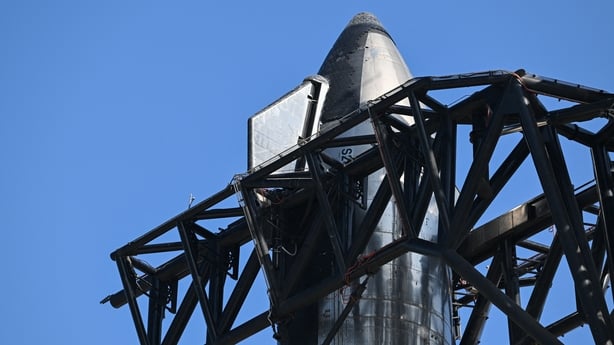SpaceX's Starship, the most powerful rocket ever built, has exploded during the first test flight of the spacecraft designed to send astronauts to the Moon, Mars and beyond.
The gigantic rocket successfully blasted off at 8:33 am Central Time (1.33pm Irish time) from Starbase, the private SpaceX spaceport in Boca Chica, Texas.
The Starship capsule had been scheduled to separate from the first-stage rocket booster three minutes into the flight, but separation failed to occur and the rocket blew up.
We need your consent to load this rte-player contentWe use rte-player to manage extra content that can set cookies on your device and collect data about your activity. Please review their details and accept them to load the content.Manage Preferences
"As if the flight test was not exciting enough, Starship experienced a rapid unscheduled disassembly before stage separation," SpaceX tweeted.
Nevertheless, SpaceX officials on the webcast cheered the feat of getting the fully integrated Starship and booster rocket off the ground for a clean launch and delared the brief episode a successful test flight.

A planned liftoff on Monday of the gigantic rocket was aborted less than ten minutes ahead of the scheduled launch because of a pressurization issue in the first-stage booster.
The US space agency NASA has picked the Starship spacecraft to ferry astronauts to the Moon in late 2025 - a mission known as Artemis III - for the first time since the Apollo programme ended in 1972.
Starship consists of a 50m tall spacecraft designed to carry crew and cargo that sits atop a 70m tall first-stage Super Heavy booster rocket.
SpaceX conducted a successful test-firing of the 33 massive Raptor engines on the first-stage booster in February but the Starship spacecraft and the Super Heavy rocket have never flown together.
The integrated test flight is intended to assess their performance in combination.
Monday's launch was scrubbed because of a frozen pressure valve on the Super Heavy booster and SpaceX needed to delay another try for 48 hours to recycle the liquid methane and liquid oxygen that fuels the rocket.
NASA will take astronauts to lunar orbit itself in November 2024 using its own heavy rocket called the Space Launch System (SLS), which has been in development for more than a decade.
Starship is both bigger and more powerful than SLS and capable of lifting a payload of more than 100 metric tonnes into orbit.
It generates 17 million pounds of thrust, more than twice that of the Saturn V rockets used to send Apollo astronauts to the Moon.
The plan for the integrated test flight was for the Super Heavy booster to separate from Starship about three minutes after launch and splash down in the Gulf of Mexico.
Starship, which has six engines of its own, was to continue to an altitude of nearly 150 miles, completing a near-circle of the Earth before splashing down in the Pacific Ocean near Hawaii about 90 minutes after launch.
SpaceX foresees eventually putting a Starship into orbit, and then refueling it with another Starship so it can continue on a journey to Mars or beyond.

